 |
[ Outlaw Genealogy | Bruce
History | Lost Chords ] [ Projects | News | FAQ | Suggestions | Search | HotLinks | Resources | Ufo ] |
 |
[ Outlaw Genealogy | Bruce
History | Lost Chords ] [ Projects | News | FAQ | Suggestions | Search | HotLinks | Resources | Ufo ] |
"Haghenild" (in Newington Kent) - Mother of the Utlaghe
Now as a fresh explanation of this hypothesis is that Hagenilde is the widow of Utlag in Kent, they seem to have control of alot land about Kent and possibly Essex. Utlag has died , when we do not know. Hagenilde as widow seems to control the estates. When she dies all the relatives come out of the wood work, Uncles and Aunts along with the sons and a daughter named Hildith , who has married either "a Norman" or Norman or a Norman named William (Also maybe referring back to the Norman William the conqueror). So in the records we find references to the "land of Hagenild" and "son of Hagenilde" and "sons of Utlag" and "Haghenild mater Vtlaghe"
All of this makes me think these were Danes or Jutes of Kent that made a seperate peace with William in 1066. But by 1190-1200 all that is changing, and the land is being taken away from them.
1170 - Alan de Inglefeld to Peter son of Hagenilde and whichever of his boys he chooses for their lives, for 10s. annual rent and all services saving the King's. Witnesses: Ilger de Inglefeld, Peter the lord's uncle, Robert Puncun, Nicholas Pincerna, Robert de la More, William de Holme and Walter his brother, Walter de Molesford, and Hugh Amis. Seal missing. ½ virgate without house or 'curia' (formerly held by Roger, brother of the grantee) and 1 a. of meadow in 'Hyda Calcebuef'. Berkshire Record Office - Englefield, Berkshire - Why was Peter son of Hagenilde so important? Is there a connection to the Utlag's in Kent?
1194-1215 - Haghenild Utlaghe - Hildith, Philip and Henry and Richard and William and Jordan, sons of Vtlag , Simon, and Adam, and Henry and Roger son of Thomas - The Outlaw's Clan in Kent
I know I don't have the complete story on this yet, but here are some very interesting records.
Haghenild seems to be a "place" as much as a name. "De Terra Haghenild" seems to be a place in or around Newington Kent and this appears to be the "Motherland" of the Utlaghe's.
What is amazing is what happened to these people? This seemed to be the "home clan" of Utlage's and we have these series of records and then nothing.
These people were contemporary with the Utlage's in Norfolk (Robert/son Alan Utlage) and Bristol (John Utlage son of Ralph) - Are they related? It seems they lost out in their attempts to retain there lands.
There aren't any later records of Outlaw's in Kent till the 1450's with Thomas Outlawe in Crayford (near Darent). Did they end up emigrating to Dublin?
The time period is of the First Baron's Rebellion and the signing of the Magna Carta.
1250-60 -Thomas Haghenild of Lowestoft and Alice his wife - a piece of land in Yarmouth
Terra De Haghenild - Hagenild - Who was Hagenild? What is the Saxon meaning ?
Hagan - Hakon - ild
Hakon - meaning of Hakon
- Hakon is "noble, of the highest race; exalted son".
Hakon \ha-kon\ as a boy's name is pronounced HAH-ken.
It is of Scandinavian origin, and the meaning of Hakon is "noble, of the highest race; exalted son". A royal name in Norway.
Hakon has 8 variant forms: Haaken, Haakin, Haakon, Hacon, Hagan, Hagen, Hakan and Hako.
Anglo-Saxon Dictionary H-N
-
Haege - hæge n. enclosure, meadow, OEG; Mdf.
haga I. m. hedge, enclosure, curtilage, WW; Mdf: fortified enclosure, B:
homestead, house,
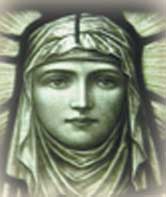 Names by Suffix
- -Hild -ilda Names -ild - is often found in Germanic feminine names. It was a very popular suffix, and
meant battle. It is also found at the beginnings of some names, including
Hildegard, and Hildred. The name Hilda is short for any and all of these names.
The Germanic hild; often became the Latin ilda.
Names by Suffix
- -Hild -ilda Names -ild - is often found in Germanic feminine names. It was a very popular suffix, and
meant battle. It is also found at the beginnings of some names, including
Hildegard, and Hildred. The name Hilda is short for any and all of these names.
The Germanic hild; often became the Latin ilda.
So Haghenild = an enclosed meadow - a fortified enclosure - a strong woman - a fortified homestead
There was also a " St. Hilda of Whitby -
Hilda of Whitby or Hild of Whitby (c. 614–680) was a Christian saint and the founding abbess of the monastery at Whitby, which was chosen as the venue for the Synod of Whitby. An important figure in the conversion of England to Christianity, she was abbess at several monasteries and recognized for the wisdom that drew kings to her for advice.
Whitby was founded under its Old English name of Streonshal in 656, when Oswy, the Christian king of Northumbria, founded Whitby Abbey, under its first abbess Hilda. The Synod of Whitby was held here in 664. In 867, the monastery was destroyed by Viking raiders, and was only refounded in 1078. It was in this period that the town gained its current name, Whitby, (from "white settlement" in Old Norse).
Continental-Germanic personal names in England in Old and Middle English times - It has long been a recognized fact that there is, especially in Middle English, a large weft of Continental-Germanic personal names and that the introduction of these names began already before the Norman Conquest...
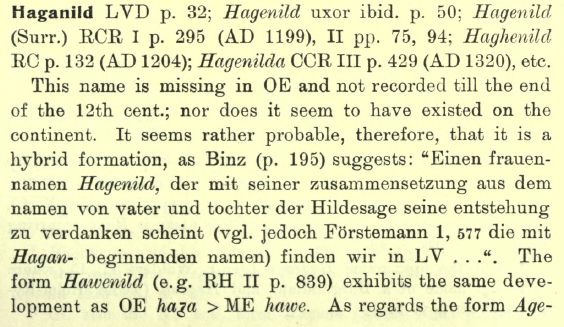

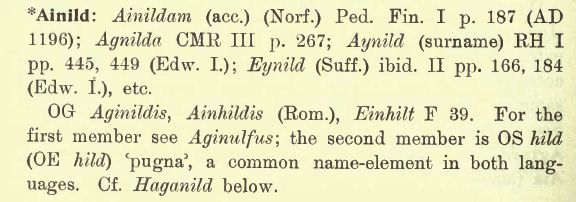
Contemporary Outlawe records:
1169 - Bromholm
Priory - House of
Glanville - Charter
of Bartholomew de Glanville To Bromholme Priory - Walteri
Utlage
1171 - The people of
Bristol were given Dublin as a colony by the king and many Bristolians
settled there.
Charter was issued by Henry II in 1171-1172, giving the men of Bristol the
right to live in the City of Dublin.
1207 - Hubert
de Burgh purchased of Roger de Burnham and Julian, his wife, William
de Noiers, Robert Fitz Ralph, and Alice his wife, and Robert de
Utlagh
1207 - Alan
the son of Robert de Vtlage
1210 - Margam
Abbey - John, son of Ralph Utlage, the
meadow of Leowine, Lewin's-mead, St. James' - Bristol
Criminals don't have land. The "Outlaw's" "plead" to the Norman's to KEEP their lands...
1200-1212 - De Helia Vtlagh - The rents which is due to the court of St. Augustine about the Mildelton - (Milton Regis Kent) - Darenth - St. Margaret's of Helles - Hagenilda de Blean - Land of Hagenild Newington Swale Kent
1213-14 - Philip son of Roger of Wermedal - Wormdale, Canterbury Cathedral Priory Witnesses: William Utelage - Wormdale, Kent
1212-1215 - Haghenild Vtlaghe - Lands of Newington - Heirs One part to Hildith married to (a) Norman William , two parts to Simon, and Adam, and Henry and Roger son of Thomas and his heirs - The register of St. Augustine's abbey, Canterbury, commonly called the Black book - Hubert de Burgh, the justice of England - Cliffe - Rochester, Kent, UK
Canterbury - its English name Canterbury, itself derived from the Old English Cantwareburh ("Kent people's stronghold"). After the Kingdom of Kent's conversion to Christianity in 597, St Augustine founded an episcopal see in the city and became the first Archbishop of Canterbury,...the inhabitants of Canterbury did not resist William the Conqueror's invasion in 1066
St Augustine's Abbey - Canterbury, England - is a ruined monastery originally founded in 598 AD by Augustine, a Roman abbot who was sent by the pope to convert the Anglo-Saxons. Rebuilt in the Norman era and almost completely destroyed at the Dissolution of the Monasteries, the ruins of the abbey are not substantial.
The Anglo-Saxon buildings were completely reconstructed in the Romanesque style following the Norman Conquest of England (1066), when it took on the form of a typical Norman Benedictine monastery. An Almonry was added in 1154 and some rebuilding was done in 1168 after a fire.
From about 1250 onwards the abbey was once again alive with building work. The cloister, lavatorium, frater and kitchen were totally rebuilt and a grand new abbot's lodging was built. The range was also extended to provide a great hall.
St Augustine's Abbey - In 978 a new larger building was dedicated by Archbishop Dunstan, to the Saints Peter, Paul, and Augustine. ... By 1100 all remains of the original Anglo Saxon building had disappeared under a massive romanesque edifice
Rochester Cathedral - The bishopric is second oldest in England: only Canterbury is older....It was badly damaged by fires again in 1137 and 1179. It was looted in 1215 by the forces of King John and again in 1264 by Simon de Montfort, during sieges of the city and its castle.... William of Normandy in 1066, he gave the church and its estates to his brother, Odo of Bayeux...Gundulf, the Norman Bishop of Rochester
Amazing:
The "Englefield's" - what connection has
"Hagenilde" to the Utlage's or have to do with the Englefield's?
Why was Peter son of Hagenild so important? Who is
Hagenild'e' ???
see the 1198 record : "Adam, son of Hagenilde"
The National Archives A2A Results - Peter Hagenild
1170 - Alan de Inglefeld to Peter son of Hagenilde and whichever of his boys he chooses for their lives, for 10s. annual rent and all services saving the King's. Witnesses: Ilger de Inglefeld, Peter the lord's uncle, Robert Puncun, Nicholas Pincerna, Robert de la More, William de Holme and Walter his brother, Walter de Molesford, and Hugh Amis. Seal missing. ½ virgate without house or 'curia' (formerly held by Roger, brother of the grantee) and 1 a. of meadow in 'Hyda Calcebuef'. Berkshire Record Office
The National Archives The Catalogue Full Details E 210-3653 - Hagenild
Full
text of The Domesday of St. Paul's of the Year MCCXXII
1222 - Hagenild,
the daughter of the molendinarius, tenant at Navestock, 80 - The Domesday
of St. Pauls of London (a miller).Navestock
Berkshire - The county is one of the oldest in England.... Berkshire has been the scene of many battles throughout history, during Alfred the Great's campaign against the Danes, including the Battle of Englefield, the Battle of Ashdown and the Battle of Reading.
Englefield, Berkshire - is a village and civil parish in Berkshire, England. The village is mostly within the bounds of the private walled estate of Englefield House. ... In 870, the village was the site of the Battle of Englefield. This was fought between the Anglo-Saxons, under Æthelwulf, Ealdorman of Berkshire, and the Danes, and resulted in a resounding victory for the Saxons. The battle was the first of a series in the winter of 870-1. The village is thought to be named after the battle: Englefield meaning either "English Field" or "warning beacon field".
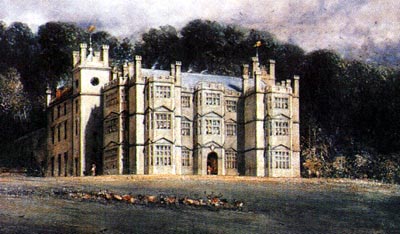 Englefield
House was the home of the Englefield family, supposedly from the time of King
Edgar.
Englefield
House was the home of the Englefield family, supposedly from the time of King
Edgar.
[ No not true ...William Fitz Ansculf (de Picquigny) Pinkney a NORMAN became the "Englefield"s
Saxon - Alwin was dispossessed]
Sir Thomas Englefield was the Speaker of the House of Commons. In 1559, the house was confiscated from his grandson, Sir Francis Englefield, a servant of the Catholic Queen Mary, for "consorting with [the] enemies" of the new Protestant monarch, Elizabeth I. The family later lived at Whiteknights Park in Earley and continued to be buried in Englefield parish church until 1822.
Berkshire History Englefield House - ... The ancient Englefield family, who were supposedly lords of the manor since the reign of King Edgar the Peacemaker, in the early 9th century, and knights of the shire in the 14th and 15th centuries, therefore occupied at least part of the present edifice.
Parishes
- Englefield - ENGLEFIELD was held under King Edward the Confessor by a certain Alwin,
and after the Norman Conquest it was apparently granted to William
Fitz Ansculf. [A NORMAN] (fn. 5) At the time of the Domesday Survey
the overlordship of the manor was vested in William Fitz Ansculf, (fn. 6) who also
held the neighbouring manor of Bradfield. (fn. 7) Englefield was one of a
small group of manors which were dependent on Bradfield and were held by
military service from its lords, the families of Paynell, Somery, de la Beche
and Langford
...
The Englefield family, which for many years held this manor under the lords of
Bradfield, claims great antiquity. The tenant of the manor under Edward the
Confessor was Alwin (see above), (fn. 11) who was apparently dispossessed,
since the manor was acquired by William Fitz Ansculf. The immediate
tenant in 1086 was Gilbert, (fn. 12) but there is no proof that he was the
founder of the Englefield family, and his name does not appear in the Englefield
pedigrees. (fn. 13) A possible supposition seems to be that William Fitz
Ansculf (de Picquigny) had enfeoffed a member of his own family, and
that this Gilbert was the ancestor of the Pinkneys, who had a
considerable holding in Englefield in the 12th century and may have been
sub-tenants of the manor. The first record of the Englefield family seems to be
in the 12th-century charters in which Ansculf de Pinkney granted a hide
of land in Englefield to Guy and the meadow of Middleham to Ellis, sons of
Ansculf Englefield. (fn. 14) By 1166 the manor was probably in the hands of the
Englefields, for in that year Ellis Englefield was one of the military tenants
of Gervase Paynell. (fn. 15)
The next lord of the manor may have been William Englefield, probably the son of Ellis, who was the donor of Englefield church to Reading Abbey. (fn. 16) The gift took place before 1184.
Another William Englefield was in seisin of the manor at the close of the 12th century; he seems to have come into his inheritance shortly before 1195–6, (fn. 17) in which year he received a quitclaim of half the vill of Englefield and lands there from his mother Maud and her husband Giles Pinkney. (fn. 18) He died childless and was succeeded before 1219 by Sir Alan Englefield, said in the family pedigrees to be his brother and heir. (fn. 19) This seems, however, to be unlikely from the evidence of a law-suit of the date of 1242–3. (fn. 20) In this Emma de Dunsterville was said to have been the mother of Sir Alan, but as William presumably was the elder, and his mother Maud was alive at the date of his succession, (fn. 21) it seems impossible that Alan could have been his younger brother; he may perhaps have been a nephew. Sir Alan was a justice for Berkshire in 1226, (fn. 22) but he seems to have died shortly after that date. (fn. 23) His son William held Englefield for many years, (fn. 24) the last mention of him being in 1258 ...
Guillaume Fitz Ansculf de Picquigny
William Fitz Ansculf, also called William of Pinkeni, was from Picquigny, Somme. He was the son of Sheriff of Buckinghamshire. Castle at Dudley, Worcs. Holdings in 12 midland and western counties.
Picquigny - is a commune in the Somme department in Picardie in northern France.... On 29 August 1475, with the Treaty of Picquigny, Louis XI brought to an end the Hundred Years War. The French king had to pay Edward IV an annual sum of fifty thousand crowns.
1194 - Jordan Utlag, Richard Uthlag and William Utlag - Rotuli curiæ regis - Sixth year of King Richard I - 1194, 18- 20 Nov - 6 Ric. I
Index - Page 57, 58 - Jordan Utlag, Richard Utlag, William Utlag ( Ric. Uthlag )
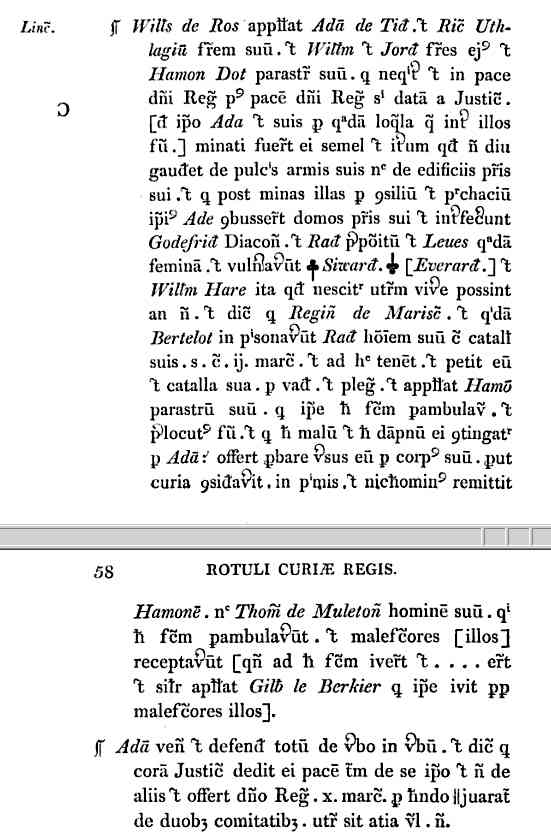
Pg. 58:
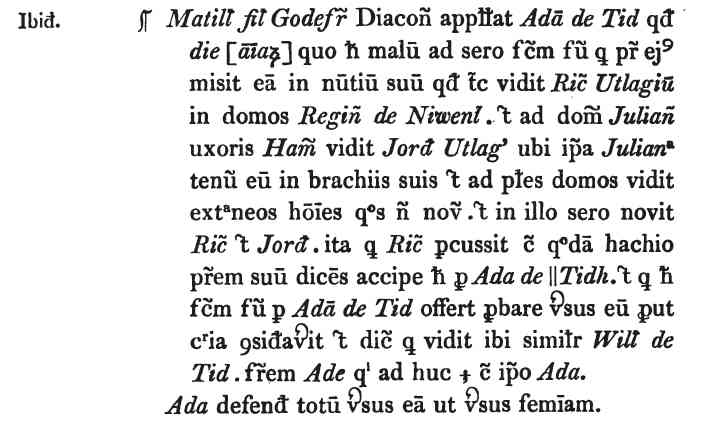
Unfortunately , I can't get a good translation from the translation software...
pg 57: Richard Utlage , brothers William and Jordan Utlage
pg58 : Maud Godfrey , Adam the Deacon, Richard Utlag, Land of
Niwent, Julian saw the wife of Ham, Jordan Utlag, William de
Tid . (Utlag ? as indicated by the INDEX)
Notice that they use of capital letters for reference to the Utlag's
What is interesting is that it refers to the "Region of Niwent"- from what has been found, this is most likely Newington, Kent
1195 - Rochester Priory - Kent. - For the manor and church of Lambeth, given the manor and church of Darenth, "with the chapel of Helles (de Helia) " , "a sheepcote in Cliffe called Estmers" and the Tenants... "the widow Hagenild" (Vtlaghe?) .
Ranulf de Glanville...Gilbert de Glanville
Lambeth was a royal manor belonging to Countess Goda, sister of Edward the Confessor. ... On these terms the business was concluded 7 Richard I (1195)
Here I found a connection between "The Widow" Hagenild (mother of the "Vtlaghe"s ) and the Glanville's in Kent, circa 1195 - See Analysis panel below - this is a Placeholder
See the next panel's - 1198 where the Utlaghe's plead to keep their "tenement in peace" and 1200-1212 "De Helia" Vtlagh
1198 - Philip, Henry, Richard, William and Jordan, sons of Vtlag’ - Kent Pipe Rolls - John 1198
Kent Pipe Rolls - John 1198 full English translation from Latin text
Concerning the tallage made by Stephen de Turneham and his
fellows
[Rot. 5, m. 2]
And half a mark from John, son of Hildith. [ Hildith Vtlag? ]
[Rot. 5d, m. 2]
Philip, son of Roger de Wermedal, [blank] half a mark, as is
written in the roll, the record concerning Maud, niece of William de Wermedal
and Roger de Wermedal made by the barons, who are noted in the preceding
roll, just as is contained there. And half a mark, as is written in the great
roll, which is recorded by the same barons, which after the fine and
concord had been made between the aforesaid Maud and Roger,
Adam, son of Hagenilde and
Philip and Henry and Richard and William and Jordan, sons of Vtlag’,
and [ possibly nephews of Hagenilde - Vtlag brothers ]
Norman de Heterham and [ Hildith married to Norman? ]
Richard and James and William, sons of Simon, and [ Simon Vtlag
? see below ]
Roger, son of Thomas, and [ Thomas Vtlag ?]
William, son of Henry, and [ Henry Vtlag ? ]
Ediua, daughter of Aldiue, and [ Vtlage - Hagenild
sister' s? ]
Edilda and Ediua, daughters of Wluron, [ Vtlage - Hagenild
sister' s ?]
... impleaded the aforesaid Roger concerning the tenement, which is noted in the preceding roll, and because it was adjudged that Roger should hold the aforesaid tenement in peace, just as is contained in the chirograph made between him and the aforesaid Maud, and because none of the aforesaid people could implead him on account that were in the country when that fine was made and they did not place any claim in that land, just as the aforesaid Roger said against them in the king’s court in a plea and they did not defend this.
Pedigree Stephen de TURNHAM
- Born: ? Died: 1214
Poss. HRE Charles VI's 16-Great Uncle. U.S. President's 21-Great Grandfather. HRH Charles's 23-Great Grandfather. PM Churchill's 22-Great Grandfather. Lady Diana's 22-Great Grandfather. Poss. `Osawatomie' Brown's 19-Great Grandfather. Poss. Jamie's 23-Great Grandfather.
Turnham, Stephen de (DNB00) - Wikisource
- Stephen de Turnham was elder son of Robert de Turnham, a knight of Kent, who
founded Combwell Priory in the reign of Henry II (Hasted,
Hist. Kent, ii. 494, iv. 236). Robert
de Turnham [q. v.] was his younger brother....
From 1197 to 1199 he had custody of the archbishop of York, was sheriff
of Wiltshire in 1199, and on 22 Nov. 1200 was one of the witnesses to the homage
of the king of Scots at Lincoln (Rog. Hov.
iv. 92, 142). In 1204 he was discharged from all accounts by a fine of one
thousand marks (Cal. Rot. Pat. p. 41). But he continued to enjoy John's
favour, and had charge of Eleanor of Brittany in 1204.
1200-1212 - De Helia Vtlagh - The rents which is due to the court of St. Augustine about the Mildelton - (Milton Kent) - Darenth - St. Margaret's of Helles - The register of St. Augustine's abbey, Canterbury, commonly called the Black book Part I
Helia ( Elijah ) Utlage or (Vtlagh from Elim - Elham) - Haghenild Utlaghe (mother) - Hildith Utlaghe (daughter) ( Very Germanic/Saxon or ?Danish/Swedish/Geatish no ? )
I have no date for this register (but it must be 1200-1212 , it is directly related to the 1198 roll above ) :
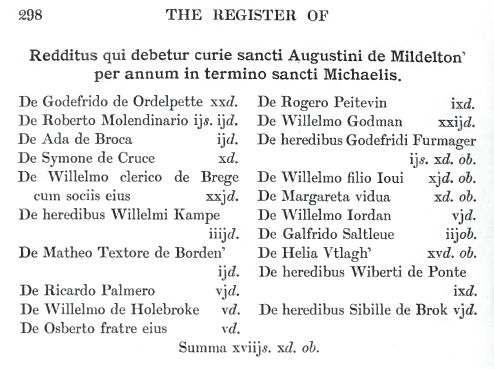
Redditus qui debetur curie sancti Augustini de Mildelton' per
annum in termino sancti Michaelis.
The rents which is due to the court of St. Augustine about the
Mildelton
" By the year, with the term of St. Michael. (This is Milton
(Regis),
Kent) Milton
Map - Street and Road Maps of Kent England UK
Milton Regis - ...the Norman Domesday Book of 1086AD records the town as Middleton Terra Regis ( Royal lands ) the Kings town of Kent. Noting it as a town and a port of wealth, whereby William the Conqueror, took it into his personal possession and gave it into the hands of his half brother Odo for safe keeping, and also appointed a portreeve (a port sheriff) whose name was Hugh de Port,to precide over the town - he was later to become Sheriff of Kent
...
De Helia Vtlagh' xvd. ob. [ -->>>This refers to "De
Helia ": Refers
to "the lost Darenth manor, St Margaret Helle (or Helles)"
]
From Elim, Vtlagh - Vtlagh from Elim [ Elham?]
1213-14 - Philip son of Roger of Wormdale , prior and convent of Canterbury Cathedral Priory Witnesses: William Utelage - Wormdale, Kent
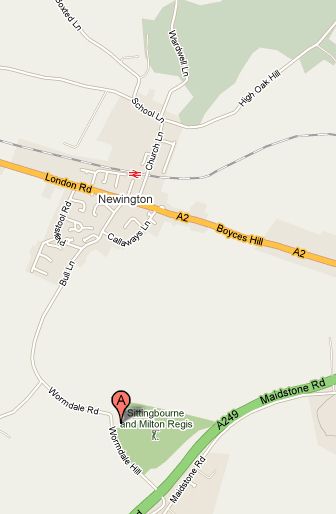 "Philip, son of Roger de Wermedal, [blank] half a mark, as is
written in the roll, the record concerning Maud, niece of William de Wermedal
and Roger de Wermedal made by the barons"
"Philip, son of Roger de Wermedal, [blank] half a mark, as is
written in the roll, the record concerning Maud, niece of William de Wermedal
and Roger de Wermedal made by the barons"
So who was Roger de Wermedal????
Well Roger de Wermedal is WORMDALE , a place near Newington/Sittingbourne called Wormdale Hill... which is now a golf course.... Wormdale, Kent, ME9 7PX, United Kingdom
In this record De Wormdale controls property on the Isle of Sheppey..
Leysdown-on-Sea - is a coastal village on the east side of the Isle of Sheppey in the Borough of Swale in Kent, England....Leysdown is located a mile to the SSE of Warden and three miles to the ESE of Eastchurch. To the SSE lies the hamlet of Shellness and to the southwest is an area of marshland known as the Leysdown marshes. To the northeast is the North Sea, with a shingle beach and mudflats extending out to sea.
Warden, Kent - Warden is a small holiday village located on the northeast coast of the Isle of Sheppey, Kent, United Kingdom.
[ "An annual payment of 20d, payable by Peter son of Ailred ('Elredus') and William and Hamo, sons of Algar ('Elgarus') le kinghe " ]
Note: Algarus (that is Earl Algar) of East Anglia) = related to William and Hamo, sons of Algar ('Elgarus') le kinghe
So this is a connection to King Edgar!
Elgarus, Ailgarus King c1232 Clerkenwell (K)
Full text of Liber Vitae Register and Martyrology of New Minster and Hyde Abbey, Winchester
Harold, the last of the Saxon kings Volume 1 - Baron Edward Bulwer Lytton Lytton
* It will be remembered that Algar governed Wessex, which principality included Kent, during the year of Godwin's outlawry
Some letters between him and Earl Algar, to whom Harold had secured the earldom of the East Angles, were discovered, and in a Witan at Winchester thou wilt doubtless have heard (for thou didst not, I know, leave thy lands to attend it), that Algar was outlawed."
Algar got ships from the Irish, sailed to North Wales, and beat Rolf, the Norman Earl, at Hereford. Oh yes, I heard that, and," added the Kent man laughing, " I was not sorry to hear that my old Earl Algar, since he is a good and true Saxon, beat the cowardly Norman, — more shame to the king for giving a Norman the ward of the Marches
| - - - - - -
So we can see the Saxon relationship even hundreds of years later. I am almost convinced that our original "name" was son's of Hagenild who was a descendent of the Edwy "clan of Outlaw's" "in-lawed by King Edgar.
Ælfgar, Earl of Mercia ... At Easter 1053 Godwin died, so Harold became Earl of Wessex, and the earldom of East Anglia returned to Ælfgar
Algar, Earl of Mercia, who died in 1059, left two sons, the earls Morcar and Edwin. They both suffered forfeiture after the Conquest; both, perhaps, died by violent deaths, nor is either of them said to have left any surviving issue. But earl Algar is said also to have left two daughters. About one of these alleged daughters, Lucia, there is much mystery, but the same legends which name her relationship to earl Algar, make her also to have been ancestress of the Anglo-Norman earls of Chester and of Lincoln. The other daughter of earl Algar is called Alditha, and said to have been wife, first of Griffyth ap Lewellyn, prince of North Wales, and secondly of Harold, son of earl Godwin. With this supposed remarriage to Harold I have nothing here to do, but if Alditha was a daughter of earl Algar, and the wife of Griffyth, she may also have been mother of Griffyth's only recorded daughter, —of that Guenta I mean whom legends would teach us to have been the wife of Fleance, or at least mother by Fleance of Alan Fitz Flaald. Again, if Alan Fitz Flaald was the legitimate son of Fleance and Guenta, and if the other circumstances alleged above be true or probable, it is also true or probable that Alan Fitz Flaald was the great grandson of earl Algar, and (setting aside attainders) one of the legitimate representatives of the Saxon earls of Mercia.
| - - - -
1213-14 - Philip son of Roger of Wormdale , prior and convent of Canterbury Cathedral Priory Witnesses: William Utelage - Wormdale, Kent
From: Philip son of Roger of Wormdale
To: the prior and convent of Canterbury Cathedral Priory
An annual payment of 20d, payable by Peter son of Ailred ('Elredus') and
William
and Hamo, sons of Algar ('Elgarus') le kinghe, for 2 salt-pans ('salina'). Also
the whole part of the marsh of Warden which fell to him, which he held of the
court of Leysdown, reserving to himself 3 salt-pans and the third part of a
mill, all in the same marsh. He will, however, pay the same amount for the lands
he retains as he used to pay for the whole tenement, namely 15d and one-third of
a penny, payable in the court of Leysdown. The grant is made for a light ('ad
luminare') for the cathedral church. Made, confirmed and read ('recitata') at
the priory's court. Dated the first year after the lifting of the general
interdict in England. Slip of parchment attached to the plica through slit for
seal tag, stating that the priory recovered an annual payment of 15½d and suit
of court of the manor of Leysdown which had been lost and not paid or performed
for 50 years from William langle and Lucy, his wife, Lucy being Philip's
heir. This was done and agreed on 16 Jul 1420, in the year of St Thomas
Becket's Jubilee, when the boundaries between the demesnes of Leysdown and
Warden were fixed there with the consent of the parties and marked with a cross
('specialiter consignata').
Witnesses: Henry of Ospringe ('Ospreng''), steward ('senescallus'); Thomas de
Dene'; Daniel de londonesforde; Nicholas the forester ('forestar''); William utelage; William of
Godmersham; Henry ferre; James
de Hag'; Columbinus; Henry Grapinel; Adam son of Godeleva ('Godelef''); William
brabazin Endorsed with description in late 13th cent hands.
( Notice the small u - I bet that Utlage was lost in latin translation - William utelage = William Utlage )
Related:
1200-1220 - Stephen
son of Roger of Wormdale To: the prior and convent of Canterbury Cathedral
Priorys
The marsh of Warden which he held of the court of Leysdown with 50
sheep, reserving the salt-pans ('salina') and the road ('via') which leads to
them. The grant is made for his soul and the souls of his predecessors and
successors. No date. [Date: handwriting.]
Witnesses: Mgr William Curteis, rural dean of Canterbury; Henry of Ospringe ('Ospreng''),
priory steward ('senescallus'); Simon the clerk; James de stablegate; Reginald
the door-keeper ('Janitor'); Reginald the door-keeper ('Janitor'); Thomas the
door-keeper ('Janitor'); Jordan the saucer ('salsar''); Michael de Bracino;
Osbert son of William of Warden; Philip, brother of Osbert son of William of
Warden; John de hokeling' Endorsed with description in mid and late 13th cent
hands and note of registration in late 13th cent hands.
1212-1215 - Haghenild Vtlaghe - lands of Newton and Newington - Heirs One part to Hildith married to a Norman William , two parts to Simon, and Adam, and Henry and Roger son of Thomas and his heirs - The register of St. Augustine's abbey, Canterbury, commonly called the Black book - Hubert de Burgh, the justice of England -
"St. Austin's Abbey. With few exceptions they occur in a chartulary
dating from the middle of the thirteenth century " [ ~1250 but this
registry entry seems to be of the time of Hubert
de Burgh which places this at between ~1200 - 1212 ] .
Notice our later 1207 record of Hubert
de Burgh and Robert de Utlagh.
The register cannot be later then 1212 - the death of Abbot Roger of St. Augustines Canterbury. But the document refers to Hubert de Burgh as Lord Justice and King John named him Chief Justiciar in June 1215. So let's say the document is 1215.....
"The abbey stood outside the walls of the city of Canterbury, among a
small group of houses, fields, and buildings known as Langport, which
formed the nucleus of its estates, and was sometimes described as Barton or
Berton"
| -- - - - - - - - Page 505
This previous entry mentions Hubert de Burgh which places a date of at least 1215 also Simon of Wardun
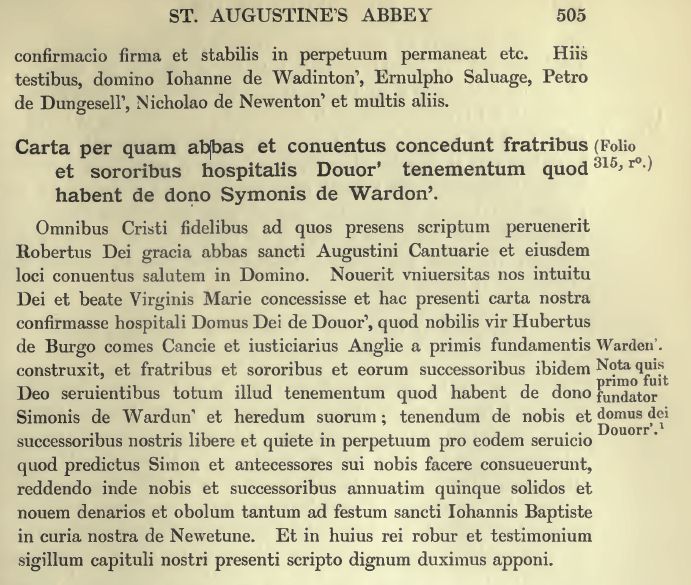
Carta per quam abbas et conuentus concedunt fratribus et sororibus hospitalis Douor' tenementum quod habent de dono Symonis de Wardon*.
Omnibus Cristi fidelibus ad quos presens scriptum peruenerit Robertas Dei
gracia abbas sancti Augustini Cantuarie et eiusdem loci conuentus salutem in
Domino. Nouerit vniuersitas nos intuitu Dei et beate Virginis Marie concessisse
et hac presenti carta nostra confirmasse hospitali Domus Dei de Donor',
quod nobilis vir Hubertus de Burgo comes Cancie et iusticiarius Anglic a
primis fundamentis Warden', construxit, et fratribus et sororibus et eorum
successoribus ibidem Nota quis Deo seruientibus totum illud tenementum quod
habent de dono f un dator Simonis de Wardun" 1 et heredum suorum ;
tenendum de nobis et domus dei successoribus nostris libere et quiete in
perpetuum pro eodem seruicio quod predictus Simon et antecessores sui
nobis facere consueuerunt, reddendo inde nobis et successoribus annuatim quinque
solidos et nouem denarios et obolum tantum ad festum sancti lohannis Baptiste
in curia nostra de Newetune. Et in huius rei robur et testimonium
sigillum capituli nostri presenti scripto dignum duximus apponi.
By the Charter of which the abbot and convent of the grant brothers and sisters of the hospital Douor 'the tenement which have of the gift of Simon de Wardone *.
To all the faithful of Christ to whom this present writing shall come, by the grace of God, Robert abbot of St Augustine of Canterbury, and the salvation of the convent of the same place in the Lord. Know ye all of that, having regard of God, and have granted to the Blessed Virgin Mary, and by this our present charter have confirmed to the hospital, On the Gift of The house of God, which is the noblest man of Hubert de Burgh, earl of Kent and the justice of England from the earliest of the foundations Warden', has built, and the brothers and sisters and their successors in the same place. Note any one those who serve God all the tenement which have of the gift giver of f un Simon of Wardun and heirs, and in the family; to be held of the house of God to us and our successors freely and for ever for the rest at the same service that the aforesaid Simon, and their ancestors were accustomed to do to us, paying thence to us and successors, annually, five shillings and nine pence and a half pence each so much at the feast of St. John the Baptist in our court of the Newetune. And of this matter and the testimony of the strength of the seal of our chapter, we think it right to the present writing set before them.
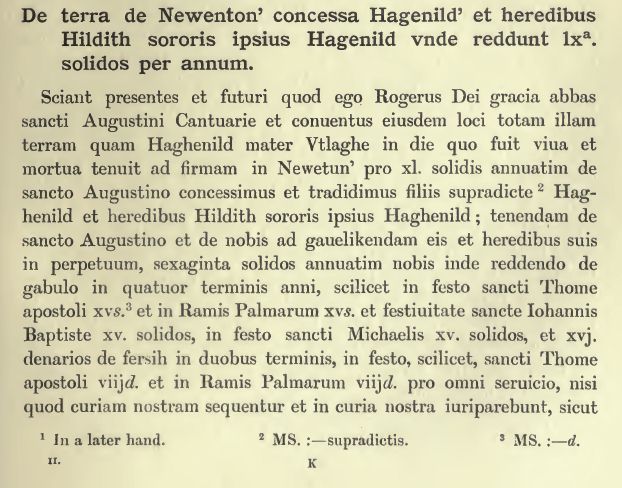

De terra de Newenton' concessa Hagenild' et heredibus Hildith
sororis ipsius Hagenild vnde reddunt 1x a . solidos per annum.
Sciant presentes et futuri quod ego Rogerus Dei gracia abbas sancti Augustini
Cantuarie et conuentus eiusdem loci totam illam terram quam Haghenild
mater Vtlaghe in die quo fuit viua et mortua tenuit ad firmam in Newetun'
pro xl. solidis annuatim de sancto Augustino concessimus et tradidimus filiis
supradicte Haghenild et heredibus Hildith sororis ipsius
Haghenild ; tenendam de sancto Augustino et de nobis ad gauelikendam eis et
heredibus suis in perpetuum, sexaginta solidos annuatim nobis inde reddendo de
gabulo in quatuor terminis anni, scilicet in festo sancti Thome apostoli xvs. 3
et in Ramis Palmarum xv,y. et festiuitate sancte lohannis Baptiste xv. solidos,
in festo sancti Michaelis xv. solidos, et xvj. denarios de fersih in duobus
terminis, in festo, scilicet, sancti Thome apostoli viijd. et in Ramis Palmarum
viijd. pro omni seruicio, nisi quod curiam nostram sequentur et in curia nostra
iuriparebunt, sicut
alii homines nostri de Newentun'. Duas autem partes illius terre tenebunt
filii Haghenild, scilicet, Vtlaghe et Simon et Adam et Henricus
et Rogerus filius Thome et heredes sui. Et terciam partem tenebunt filii
Hildithe, scilicet, Nortmannus | et Willelmus et heredes sui. Et hanc
conuencionem tenendam fideliter affidauerunt Vtlaghe et fratres eius et
heredes Hildith, Normannus et Willelmus, primum in manu lohannis filii
Viuiani tunc senescalli sancti Augustini, et postea hoc ipsum in capitulo nostro
super sacrosancta ewangelia iurauerunt. Et sexaginta solidos nobis de releuio
dederunt. Hiis testibus, Willelmo filio Nigelli, lohanne filio Viuiani, Brianel
de Middeltun' et multis aliis.
| - - - - - --
[ Here's a translation that I've been working on (seems close ).... Haghenild Utlaghe seems to own the land about Newetune and is inherited by Hildith and heirs. The abbey is paying the heirs of Haghenild for the use of the land ... It seems that "Mother" or Dower Haghenild is an ancestor and possibly before the conquest and that "sister" Hildith is the current holder of the land. That the land is to be inherited to the son's and daughter's of Utlaghe?
The children of Haghenild: Two parts to: Simon, Adam, Henry, Roger son of Thomas and one (third - see Widow / Dower inheritance below ) part to the daughter Hildith who has married into "the Normans and William" Who is William? The conqueror? So this is a Saxon-Norman marriage contract? where one-third goes to the Norman's ? ]
Out of the land of Newton, Hagenild granted to Hagenild 'sister' s and the heirs of Hildith Hagenild , whence we pay sixty shillings a year.
Seneschal - the sénéchal was the king's representative charged with the application of justice and control of administration
Utlage, Helias, 298. - De Helia Vtlagh' xvd. ob.
Utlaghe, Hagenild filia, 505.
, Hildith filia, 505.
Hubert de Burgh, 1st Earl of Kent - (c. 1160 – before 5 May 1243) was Earl of Kent, Justiciar of England and Ireland, and one of the most influential men in England during the reigns of John and Henry III. De Burgh was the son of Walter de Burgh of Burgh Castle, Norfolk. He was the younger brother of William de Burgh (d. 1206) who accompanied Prince John, to Ireland in 1185, and eventually became Lord of Connacht. Hubert and William's two younger brothers, Geoffrey and Thomas, became Archdeacon of Norwich (1202) and then bishop of Ely (1225), and castellan of Norwich (1215–16) respectively. - John named him Chief Justiciar in June 1215 ... After the death of William Marshal in 1219, de Burgh effectively became regent of England... On 27 April 1228 he was named Justiciar for life
Newenton - afterwards spelt Newenton, and Newington - Manor of Walworth. - The only manor in this parish is that of Walworth, now a hamlet to Newington, and the birth-place probably of the celebrated citizen who bore its name. King Edmund gave this manor to his jester Nithardus, who in the reign of St. Edward, being about to make a pilgrimage to Rome, obtained a licence from that monarch to give it to the church of Canterbury (fn. 3) . This manor in Doomsday Book, called Waleorde, is said to have been held in the time of William the Conqueror by Bainardus of the Archbishop of Canterbury, and to have been appropriated to the support of the monks
Newington, London - The name means "new farmstead" or the newer part of the manor of Walworth - In 1313 it is mentioned again in the Archbishop of Canterbury's Register as Newington juxta London
Parishes - Newington - THE next parish southward from Halstow is Newington, written in Domesday, Newetone, which certainly took its name from its having been raised on the site of some more ancient town, perhaps built in the time of the Romans, of whom there are many vestigia in and about this place ... The manor of Newington remained part of the possessions of the monastery of St. Augustine, till its final dissolution, in the 30th year of king Henry VIII. when this great abbey, with all its revenues, was surrendered up into the king's hands. ... St. Augustine's, near Canterbury, who seems to have had possessions here long before
Newetun - North Newton, Somersett
North Petherton (includes North Newton) - The name derives from the area's location to the north side of the River Parrett, from the Latin Paradæ 'barge' and from the Old English nor tun - The former Royal Forest (hunting ground) of North Petherton dated from long before the Norman Conquest until the 17th century, and was expanded by Henry II. - The Civil parish of North Petherton includes the villages of North Newton (on the route of the Bridgwater and Taunton Canal) and Northmoor Green (also known as Moorland) in the Somerset Levels, as well as a number of other smaller settlements
Haghenild - Continental-Germanic personal names in England in old and middle English times
Haganild LVD p. 32; Hagenild uxor ibid. p. 50; Hagenild (Surr.) ECR I p. 295 (AD 1199), II pp. 75, 94; Haghenild EC p. 132 (AD 1204); Hagenilda COR III p. 429 (AD 1320), etc. This name is missing in OE and not recorded till the end of the 12th cent.; nor does it seem to have existed on the continent. It seems rather probable, therefore, that it is a hybrid formation, as Binz (p. 195) suggests: *^Einen frauen- namen Hagenild, der mit seiner zusammensetzung aus dem namen von vater und tochter der Hildesage seine entstehung zu verdanken scheint (vgl. jedoch Forstemann 1, 577 die mit Hagan- beginnenden namen) finden w^ir in LY . . .". The form Hawenild (e.g. EH II p. 839) exhibits the same development as OE ha^a > ME hawe. As regards the form Age- 138 nilda MRS p. 19 it is not to be determined with certainty whether it is < Hagenilda, which, indeed, seems most probable, or identical with *Ainilda (above); cf. the Latinized form Agenulfus by the side of ^mwZ/" (under Aginulfus above)^ Magyar, Hager, see Harger.
Full text of Archaeologia cantiana
By the Common Law of England, the widow had a right to one-third of her husband's possessions for dower, and by the custom of Kent one-half. But there was another kind of dower, called " ad ostium ecclesie." This was made by the husband immediately after the marriage, and therein he specifically named the particular lands with which his wife was to be endowed. By this species of dower he could not settle upon his wife more than one-third of his possessions, but he might endow her with less. The advantage of this method was that the particular portion of the property to which the widow was entitled was immediately known, being specifically declared by the husband, so that, after his death, she could at once enter on that particular land, without any further claim for dower.
BOOK
III. FROM THE INSURRECTION OF THE ENGLISH PEOPLE AGAINST THE NORMAN FAVOURITES
OF KING EDWARD, TO THE BATTLE OF HASTINGS. 1048—1066. - History of the
Conquest of England by the Normans; Its Causes, and its Consequenc
The Duke of Normandy offered good pay and the pillage of England to every
able man who would serve him with lance, sword, or cross-bow. A multitude
accepted the invitation, coming by every road, far and near, from north and
south ... others simply required some rich Saxon in marriage
Houses of Benedictine monks - The abbey of St Augustine, Canterbury
Roger, elected 1176, (fn. 103) blessed 1179, died 1212
Elham - (pronounced Eel-um) is a village in East Kent situated approximately 9 miles (14 km) south of Canterbury and 5 miles (8 km) north east of Folkestone in the Elham Valley.... Elham is situated deep in the heart of the North Downs and within the Kent Downs Area of Outstanding Natural Beauty.
Elham - Boyke
Manor - Park Gate Down just
under a mile north west of Elham is a small nature reserve but one of the top
orchid sites in the country. This grassland site supports up to 12 different
species of orchid during May and June, some of which are nationally scarce.
In high summer large numbers of butterflies, including Marbled Whites and
Chalkhill Blues, can be seen on the reserve. Elham
Valley Way - The route passes through some of the finest
landscapes in Kent, part of the nationally protected Kent Downs Area of
Outstanding Natural Beauty.
Milton-next-Gravesend
- one of the ancient ecclesiastical
parishes in the NW of the county of Kent,
England
Christ Church, Milton-next-Gravesend, Kent, England - is actually part of the town of Gravesend, a very historic town at the end of the Thames east of London. The town appears in the Domesday Book as Gravesham and was at the time owned by Odo, Bishop of Bayeux.
Pocahontas, the native American princess from the Virginia colony who had
married the English settler John Rolfe and had returned to London with him,
died on board a ship returning to Virginia in March
1617
just as it left Gravesend. She is buried in the graveyard of St George's
church in the town centre, although the exact location of the grave is
unknown.
1195 - Rochester Priory - Kent. - For the manor and church of Lambeth, given the manor and church of Darenth, "with the chapel of Helles" , "a sheepcote in Cliffe called Estmers" and the Tenants... "the widow Hagenild" (Vtlaghe?) . Ranulf de Glanville...Gilbert de Glanville - Lambeth was a royal manor belonging to Countess Goda, sister of Edward the Confessor. ... On these terms the business was concluded 7 Richard I (1195)
In 1190-1195 Canterbury ( Hubert Walter ) trades ("Outlawe") land in Darenth Manor with Rochester Priory ( Gilbert de Glanville ) in return for land to build Lambeth Palace , this seems to be the beginning of troubles for the Utlage's in Kent.
...
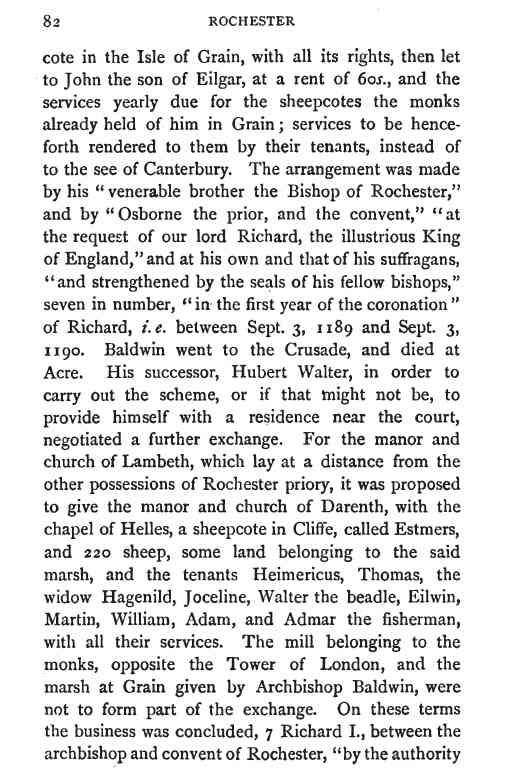 In 1182
Walter died. When Walter was dead and buried, the archbishop, Richard, took
possession of the property of the see, and anathematized all who should do
anything contrary to the dignity and prerogatives of the metro-political church.
Ranulf de Glanville, the Justiciar, forbad him to act without the royal
sanction.
In 1182
Walter died. When Walter was dead and buried, the archbishop, Richard, took
possession of the property of the see, and anathematized all who should do
anything contrary to the dignity and prerogatives of the metro-political church.
Ranulf de Glanville, the Justiciar, forbad him to act without the royal
sanction.
...
Whatever his wishes may have been, he had little opportunity of giving effect to
them ; for while preparing for a journey to Rome, which the king desired him to
undertake, and where it is supposed he hoped to persuade the pope to sanction
the removal of the "regulars " in his cathedral, in favour of the
"seculars" whom Gundulf had expelled, he was seized with an
illness at Rochester, which proved fatal, August 29, 1184. The monks then barred
the gates of the convent, and buried him privately, placing the pastoral
staff in the coffin that they might not send it to Canterbury.
Gilbert de
Glanville, a native of Northumberland, Archdeacon of Lisieux in Normandy, was
the next Bishop of Rochester. His election took place July 17, 1185;
... Gilbert de Glanville, built a town residence for himself and his
successors.
In Saxon times Lambeth was a royal manor. It belonged to the Countess Goda,
sister of Edward the Confessor.
She bestowed it on the church of Rochester, but
it was afterwards in the possession of Harold, and from him passed to the
Conqueror, who gave a portion of it to his half-brother Odo. Rufus, by a
charter signed with his mark, and still extant in the British Museum, restored
the whole to the former owners, with the advowson, "for the food of the
monks."...
We may suppose that there was then on the property a dwelling for the bailiff, where business could be transacted, and where the bishop or prior of Rochester might find temporary accommodation.
When Archbishop Baldwin wished
to found a college, with the real, if unavowed, object of freeing himself
from the interference of the Canterbury chapter, he obtained from the Rochester
authorities, on the failure of his plans at Hackington and Maidstone, a part of
their ** court " at Lambeth, with twenty-four acres and a pole of the
demesne " to build a church in honour of the blessed martyr St. Thomas,
and houses for the canons to serve there."
...
Baldwin went to the Crusade, and died at Acre. His successor, Hubert
Walter,
in order to carry out the scheme, or if that might not be, to provide himself
with a residence near the court, negotiated a further exchange.
For the manor and church of Lambeth, which lay at a distance from the other possessions of Rochester priory, it was proposed to give the manor and church of Darenth, with the chapel of Helles,
a sheepcote in Cliffe, called Estmers, and 220 sheep, some land belonging to the said marsh,
and the tenants Heimericus, Thomas, the widow Hagenild,
Joceline, Walter the beadle, Eilwin, Martin, William, Adam, and Admar the
fisherman, with all their services. The mill belonging to the monks, opposite
the Tower of London, and the marsh at Grain given by Archbiishop Baldwin,
were not to form part of the exchange.
On these terms the business was
concluded, 7 Richard I., between the archbishop and convent of Rochester,
"by the authority and consent of Gilbert their bishop." ^ At this time
he held the rectory of Lambeth with his see, and was entitled to certain
accommodation when visiting London ; he therefore made his sanction to the
transfer conditional on a pension of five marks being secured from the rectory
to the bishoprick,^ and the grant of a piece of ground near Lambeth church on
which to build a house. The mansion was known as " La Place" and
continued to be the town residence of the bishops until the attainder of Bishop
Fisher, when it was appropriated by Henry VIII, and afterwards given by him to
the see of Carlisle
Rochester
Cathedral - The
bishopric is second oldest in England:
only Canterbury
is older....It was badly damaged by fires again in 1137 and 1179. It was
looted in 1215 by the forces of King John
and again in 1264 by Simon de Montfort, during sieges of the city and
its castle....
William
of Normandy in 1066, he gave the church and its estates to his
brother, Odo
of Bayeux...Gundulf,
the Norman Bishop of Rochester
Lambeth Palace illustrated by a series of views By Edward Wedlake Brayley, William Herbert
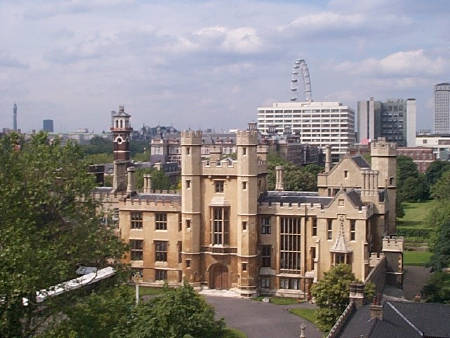 Lambeth
Palace - London residence of the Archbishop of Canterbury for more than 800
years.
Lambeth
Palace - London residence of the Archbishop of Canterbury for more than 800
years.
The city and liberty of Rochester - The priory and cathedral church British History Online
ABOUT THE YEAR 600, Ethelbert, king of Kent, at the instance of St.
Augustine, began to build a CHURCH at Rochester, in honour of St. Andrew, and a
MONASTERY adjoining to it, of which church St. Augustine in 604, appointed
Justus to be bishop, and placed secular priests in the monastery; for the
maintenance of whom the king gave a portion of land to the south of the city,
called Prestefelde; to be possessed by them for ever, and he added other parcels
of land, both within and without the walls of the city. (fn. 1) And
notwithstanding in after times the gifts to this church were many and extensive,
yet by the troubles which followed in the Danish wars, it was stripped of almost
all of them, and at the time of the conquest it was in such a state of poverty,
that divine worship was entirely neglected in it, and there remained in it only
five secular priests, who had not sufficient for their maintenance.
Many of the possessions belonging to the church of Rochester had come into the
hands of the conqueror at his accession to the crown, most of which he gave to
his half-brother, Odo, bishop of Baieux, from whom archbishop Lanfranc recovered
them, among other lands belonging to his own church, in the solemn assembly of
the whole county, held by the king's command at Pinnenden-heath, in the year
1076.
Soon after this, Gundulf was elected bishop of Rochester, to whom and to this
church, archbishop Lanfranc immediately restored all those lands which he had
recovered, formerly belonging to it.
...
Bishop Gilbert de Glanvill, who came to the see in 1185, is recorded
to have rebuilt all that had been burned down of this palace by one of those
dreadful fires which laid waste the greatest part of this city
| - - - - - - - - -- - - - - - - - - - - - - - - - - - -
A sheepcote in Cliffe, called Estmers ...
Parishes - Cliff British History Online
NORTH-EASTWARD from Higham lies Cliff, called in antient records,
Clive, and sometimes Bishop's Clive. It is likewise called Cliff
at Hoo, from its nearness to that hundred, and Cliff near Rochester and
Gravesend, to distinguish it from the parish of Cliff near Dover. This
parish, as well as that near Dover, are both frequently stiled West Cliff;
the former as being situated westward of the latter; and the latter, as being
situated westward of St. Margaret at Cliff, the adjoining parish
eastward from it.
This place takes it name from the cliff or rock on which it stands. It
is by many supposed to have been the place called, in the time of the Saxons,
Cloveshoe, where several councils were held by the British bishops,
of which a further account will be given.
...
PRIOR'S-HALL, with other premises, which archbishop Lanfranc retained in
this parish, as part of the revenues of the see of Canterbury, as has been
already mentioned, remained in the possession of the archbishops till Hubert,
archbishop of Canterbury, in the year 1195, anno 7 Richard I. with the king's
consent, and for the mutual benefit of the churches of Canterbury and Rochester,
exchanged, among other premises, a
sheepcote in Clive, which was called Estmers, with two hundred and twenty sheep,
and certain land in Clive, belonging to it, and certain tenants
in this parish, with the lands which they held, and the rents, services,
and customs, without any reservation to the archbishop and his successors, for
the manor of Lambeth, &c. with the monks of St. Andrew's, in Rochester,
to the use of their refectory, in like manner as they before had the manor of
Lambeth, saving to the bishop of Rochester all episcopal right, (fn. 13) &c.
which exchange was confirmed that year by king Richard I. and afterwards by king
John, in his first and second years.
The priory of St. Andrew's continued in possession of these premises and the
manor belonging to them, called Prior's hall, till the time of its dissolution,
which happened in the 32d year of king Henry VIII. when it was, with all the
rents and revenues belong ing to it, surrendered into the king's hands, who soon
afterwards, by his dotation charter, in his 33d year, settled the manor of
Prior's-hall on his new founded dean and chapter of Pochester, with whom the
inheritance of it now remains.
Councils of Clovesho - The Councils of Clovesho were a series of synods in England in the eighth and ninth centuries.
The location of Clovesho has never been conclusively identified...Older suggestions were Cliffe near Rochester, Kent, previously known as Cliffe-at-Hoo.
Cliffe - Rochester, Kent, UK - Cliffe (sometimes known as Cliffe-at-Hoo) is a village on the Hoo peninsula in Kent, England, reached from the Medway Towns by a three-mile journey along the B2000. Situated upon a low chalk escarpment overlooking the Thames marshes, Cliffe offers the adventurous rambler views of Southend-on-Sea and London. It forms part of the parish of Cliffe and Cliffe Woods in the borough of Medway.Clovesho, or Clofeshoch, was an ancient Saxon town, in Mercia and near London,[1] where the Anglo-Saxon Church is recorded as holding the important Councils of Clovesho between 742 and 825.
In 774 Offa, King of Mercia, built a rustic wooden church dedicated to St Helen, a popular Mercian saint who was by legend the daughter of Coel ('Old king Cole') of Colchester. St Helen's church at Cliffe was built about 1260 and was constructed in the local style of alternating layers of Kent ragstone and squared black flint. It is one of the largest parish churches in Kent, and the only dedicated to St Helen, the size of the church revealing its past importance.
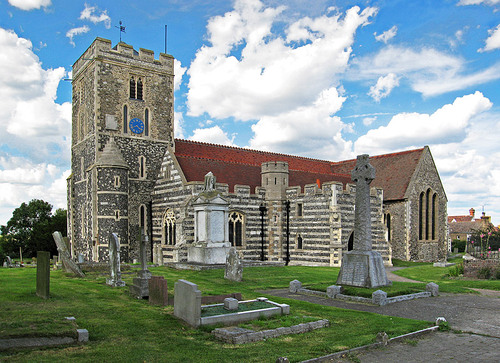 Cliffe - St. Helen's
Church
Cliffe - St. Helen's
Church
"a sheepcote in Clive, which was called Estmers, with two hundred and twenty sheep, and certain land in Clive"
sheepcote - a pen for sheep
Estmers - is probably meaning "East Mersea" in the Thames Estuary ... but it seems to far away and not in Cliffe.... It sounds like it would have been a small marsh island in the estuary in Cliffe (Clive) so they could easily pen the sheep.
Mersea Island - (formerly Mersey Island) is the most easterly inhabited island in the United Kingdom, located marginally off the coast of Essex, England, 9 miles (14 km) to the southeast of Colchester. It is situated in the estuary area of the Blackwater and Colne rivers and has an area of around 7 square miles (18 km2).[1] The name 'Mersea' is derived from the Old English meresig meaning 'island of the pool',
There are two main settlements on the island, the small town of West Mersea and the village of East Mersea, plus a small hamlet at Barrow Hill to the north of West Mersea.
| - - - - - - - - - - - - - - - - - - - - - - - - - - - - - -
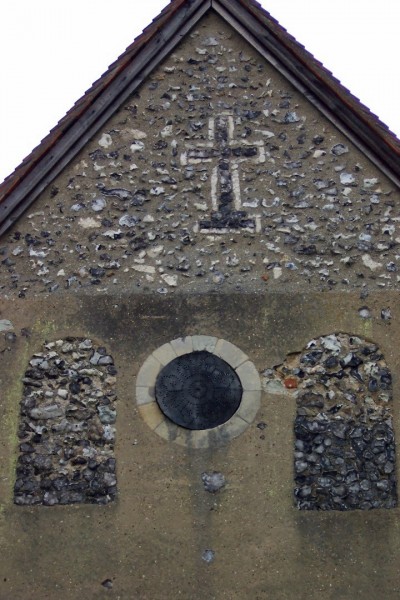 The
gentleman's magazine - Darenth Church - Kent ...
The
gentleman's magazine - Darenth Church - Kent ...
The Church of Darenth is dedicated to St. Margaret, as was also the daughter, or rather sister church of
Helles. The benefice is a discharged vicarage, and a peculiar of the Archbishop of Canterbury. This parish is sometimes styled North Darent, which is no doubt a modern appellation, rendered necessary by the increase of the village of
South Darent, about a mile further, which had also its church, at a period when the spiritual wants of the population were deemed a solemn obligation.
Some slight remains of this church or chapel of the hamlet are still in being, and a very considerable portion of St. Margaret's existed when Mr. Thorpe compiled his work.
E. I. C.
Darenth - is a village and civil parish in the Dartford District of Kent, England. The parish is located to the south-east of Dartford town; the village is three miles (4.8km) from there.
The ancient and beautiful parish church is dedicated to St. Margaret of Antioch 10th century ----
Church- gable end and priest hole - We have a small 'priest hole' or space above the altar and this outside entrance is the only way in.
More Hagenild references in the St. Augustine's Black Book Volume I :
registerofstaugu02stauuoft_bw_Black_Book_Part_I.pdf
Hagenild relicta Northmanni Chirich
Chirich, Northmannus, 37. [ Who was Northman Norseman? Chir-Rich
Church? ]
, , Hagenild his widow, 37.
Hagenild et Felicia filie Willelmi Textoris
Hagenild daughters of William and happiness, of the weaver
Gravesend
, Kent - Darenth - The antiquity of the place is all but swamped
now but the village was once given by King Athelstan (AD 925-940) to Duke
Eadulf and later passed into the possession of Christ Church at
Canterbury, to become one of the manors of the Archbishop of Canterbury.
Archbishop Hubert Walter exchanged the church and manor of Darenth for the
manor of Lambeth in 1195.
Two of the smaller Darenth
manors, St Margaret Helle (or Helles) and Clequdon have since become lost.
The chapel of St Margaret Helle was mentioned in the Textus Roffenses,
where it was assessed at sixpence a year payable to Rochester Cathedral. In 1522
Archbishop Warham ruled that although it could baptise and bury local people,
marriages could only be solemnised at the parish church, which was some distance
away.
Nothing of the chapel remains today but the parish church continues to
be dedicated to St Margaret, also. It dates from the l0th century and its
fabric contains remnants of a nearby Roman villa on the banks of the River
Darent which was excavated in 1894/95. One of the features of the church is the
great sculpted Romanesque font which dates from about 1140. The church, which
stands on Darenth Hill, is said to be the third oldest in Kent, having been
built in about AD 940 although, of course, added to after that. It was
largely destroyed by fire in 1710 and restored.
So the bit that goes "De
Helia ": Refers
to "the Darenth manor, St Margaret Helle (or Helles)"
De Helia Vtlagh' xvd. ob.
HILLS OF ENGLAND IN AMERICA In 1632 - Hills - Family History - In THE HILLS FAMILY IN AMERICA the chapter on heraldry attempts to trace the Hills into antiquity. The authors link the Hills of Upminister to the de Helles/Hills families and other variations to St, Margaret Hills/Helles/de Helles at Darenth, Kent England. Hills is called a vulgarization of the name Helles. Upminister is about 8 miles from St. Margaret's. The link is by assumption rather than proof.
Notes on the churches in the counties of Kent, Sussex, and Surrey.djvu-138 - Wikisource - the manor and church of Darenth, with the chapel of Helles
212. St. Margaret's, Darent.—In a document, bearing date in A.D. 1522, to the church of Darent is annexed a chapel "vulgariter nuncupata (vulgarly called) Sancte Margarette Hillis, Grensted, Southedalent, Gillis, et Hillis." (Reg. Roff.)
In the description of Darent, toward the close of the last century, it was said, "There are still remaining here the flint walls of an antient building, most probably the church or chapel of South Darent, now used as a malt-house, the building of which stands due east and west." (Hasted.) Unless Thorpe (in his Gust. Roff.), (see the Note on Darent), is wrong in stating South Darent to have been joined with Horton Kirby parish, I conceive Hasted in the above passage, especially compared with the following quotation from him, can only mean St. Margaret's.—The chapel of Helles is named in a decision of Archb. John Peckham,
A.D. 1292.—St. Margaret Helles seems, from various old records, "as to its temporal jurisdiction, to have been once a parish of itself, distinct from that of Darent, having within its bounds the several hamlets of Hilles, Grensted, South Darent, and Gills. However, as to its ecclesiastical jurisdiction, it was always accounted but as a chapel to Darent, having the above hamlets within its precincts." It was united with Darent in 1557 (by Cardinal Pole, Harris), after which it was suffered to fall into ruins. Of a portion of the tower then existing it is added, "In the remains of this building there are many Roman bricks, and part of an arch is
Milton-next-Gravesend - one of the ancient ecclesiastical parishes in the NW of the county of Kent, England
Christ Church, Milton-next-Gravesend, Kent, England - is actually part of the town of Gravesend, a very historic town at the end of the Thames east of London. The town appears in the Domesday Book as Gravesham and was at the time owned by Odo, Bishop of Bayeux.
Gravesend, Kent - lies immediately to the north of their road connecting London with the Kent coast – now called Watling Street. The Domesday Book recorded mills hythes and fisheries here.[4]
In the Fort Gardens is Milton Chantry, Gravesend's earliest existing building of the late 13th century. It was refounded about 1321 on the site of a hospital founded in 1189. At the time it was supported by lands in Essex.
Gravesend has one of the oldest surviving markets in the country, its earliest charter dating from 1268. Town status was granted to the two parishes of Gravesend and Milton, the Charter of Incorporation being received in that year. The first Mayor of Gravesend was elected in that year, although the first Town Hall was in place by 1573
 Kent
Parish Councils - Newington Parish Council - The
Parish of Newington is located in the Borough of Swale in North Kent. It lies
astride Watling Street (A2) two miles east of Rainham and the same distance
from Sittingbourne.
Kent
Parish Councils - Newington Parish Council - The
Parish of Newington is located in the Borough of Swale in North Kent. It lies
astride Watling Street (A2) two miles east of Rainham and the same distance
from Sittingbourne.
Newington, Swale - a village in Kent, England on the A2 road (originally a Roman road) between Chatham to the west and Sittingbourne to the east. The local district council is Swale. The village has its own Railway Station which is situated on the Chatham Main Line between Sittingbourne and Rainham.
Update: I goofed this up... This most likely Milton-Regis near Newington...
Milton Regis - ...the Norman Domesday Book of 1086AD records the town as Middleton Terra Regis ( Royal lands ) the Kings town of Kent. Noting it as a town and a port of wealth, whereby William the Conqueror, took it into his personal possession and gave it into the hands of his half brother Odo for safe keeping, and also appointed a portreeve (a port sheriff) whose name was Hugh de Port,to precide over the town - he was later to become Sheriff of Kent
Parishes - Darent - The name of this parish is spelt, in some antient writings, Darente and Deorwent; and in Domesday, and some others, Tarent. It takes its name from the river Darent, which runs through it. This place was sometimes called North Darent, to distinguish it from the neighbouring parish or hamlet of South Darent.
ATHELSTANE, king of England, gave the perpetual inheritance of Darent to duke Eadulf, who, in the year 940, with the king's consent, gave it to Christ church, Canterbury, in the presence of archbishop Wlselm, free from all secular service and regal tribute, excepting the trinoda necessitas, of repelling invasions, and the repair of castles and highways. (fn. 2) Soon after this, whilst Ælsstane was bishop of Rochester, who came to the see in 945, and died in 984, one Birtrick, a rich and potent man, who then resided at Meophum, devised his land at Darent, with the consent of Ælfswithe his wife, by his will and testament (a most curious record of the customs of those times,) to one Byrware, for his life, and afterwards to the priory of St. Andrew, in Rochester, for the good of himself and his ancestors. This estate seems to have been wrested from the church of Rochester, in the troublesome times which followed soon after. (fn. 3) But the manor of Darent remained, according to duke Eadulf's gift, among the possessions of Christ church at the consecration of archbishop Lanfranc, in the 4th year of the Conqueror's reign; who, among many other regulations which he made, after the custom of foreign churches, for the benefit of his monastery, separated the manors of his church (for before this, the archbishop and his monks lived together, as one family, and had their revenues in common) allotting one part for himself and his successors in the archbishopric, and the other to the monks, for their subsistance, cloathing, and other necessary uses of the monastery.
Archbishop Hubert, in the year 1195, anno 7th king Richard I. with that king's consent, and for the mutual benefit of the churches of Canterbury and Rochester, exchanged, for the manor of Lambeth, with its appurtenances there, in Southwark and in London, then belonging to the monks of St. Andrew's priory, in Rochester, his manor of Darent, with the church and the chapel of Helles, with all liberties and free customs, and all other things belonging to the manor, saving to the archbishop, and his successors, all spiritual jurisdiction in the church of Darent, until he or they should, of their mere bounty, grant it to the bishop of Rochester, so that the monks should possess it to the use of their refectory, in the same manner as they before had the manor and church of Lambeth, saving to the bishop of Rochester, in this exchange, the right he before had within the manor of Lambeth. And it was declared, that the manor of Lambeth should continue unalienable from the archbishopric, as well as the manor of Darent, and other premises so exchanged, from the church of Rochester. (fn. 4)
The manor of Darent after this appears to have been part of the possessions of the priory of Rochester; but bishop Gilbert de Glanvill, who came to the see in 1185, disputing with his monks for the recovery of several manors and possessions, formerly belonging to the see of Rochester, which bishop Gundulp, his predecessor, had given them, claimed this manor and church, with its appurtenances, as having been given in exchange for Lambeth; notwithstanding which, the prior and convent still continued in possession of them.
Meopham - is a large linear village and civil parish in the Borough of Gravesham and ceremonial county of Kent, in England, and lies to the south of Gravesend.
The name of the village derives from Meapaham (Meapa's village): it is first recorded in 788, in the time of King Offa. The modern pronunciation of the name comes from different ways of writing and spelling.[3] One of the hospitals founded during the Middle Ages was located here;[4] and three medieval manor houses - those of Meopham, Dodmore and Nurstead - governed the land now occupying the parish
Hundred of years later we have John Outlawe in Crayford:
Land of Haghenild in Newington Kent
The register of St. Augustine's abbey, Canterbury, commonly called the Black book Part I
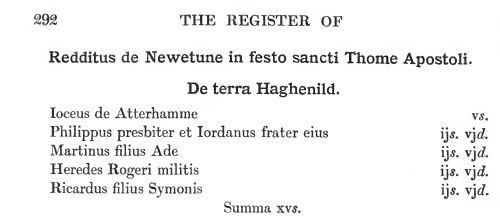
Redditus de Newetune in festo sancti Thome Apostoli.
De terra Haghenild
The
rent of Newetune
the
Feast of St. Thomas
the
Apostle.
From the land of Haghenild
Heredes Rogeri militis
The heirs of Roger, knight ( So was Hagenild the widow of Roger a [Saxon] Knight that we never know the "name of" ? )
Summa sine Haghenild
Summa tocius in equinoctio cum redditu Hagenild
The sum of Haghenild without
Total of the whole with the rent in the equinoctio Hagenild
Around the 1215 -time period we have Roger de Leybourne
"Sir Roger de Leybourne ( “Roger 1”) was credited with being one of the barons who forced King John to sign the Magna Carta at Runnymeade in 1215. Also in that year he was one of 140 barons who held Rochester Castle against the King. However they had to eventually surrender, and Roger’s estates were confiscated. " So in 1215 - Roger de Leybourne , Knight was "Outlaw"...
Kent Parish Councils -
Leybourne Parish Council
...
THE WARRIOR LEYBOURNE’S (1166–1389AD)
In 1166 a Yorkshire connection arises. Philip and Michael de Laibron, a family of Breton origins, who lived in Leyburn in Yorkshire, came to Kent and owned “ 7 Fees in
Kent”. Leyburn is an important market town in Wensleydale.
Philip changed his name, and built Lillebourne Castle on the site in 1166 during the reign of Henry II. The arms of the Yorkshire Leybornes are still basically the same as
the Kent Leybournes (note the continued different spellings), namely “Azure Six Lions, 3,2,1, Argent”. The only difference being a red background for Yorkshire and blue for Kent.
Arms of the Yorkshire Family
Lillebourne means “Lilla’s stream” and what relationship there is between the name and that of “Leyburn” in Yorkshire is uncertain. But it is perhaps not without significance that in the course of the 12th century the old form of the Kentish name gives way to Layburne and Leybourne as if the Yorkshire name had influenced it. Later variations of the name include : Laburn, Layburn, Layborn, Layborne,
Laybourne, Laybourn, Leiburn, Leyborne, Leyburn, Leyburne and many more.
Philip died in 1194, leaving an only son, Robert.
Sir Robert de Leybourne, Lord of Bures, was in the service of Richard The Lion-heart and may have fought with him at the Battle of Acre in
1191.
He died in 1199, also leaving one son, Roger Sir Roger de Leybourne ( “Roger 1”) was credited with being one of the barons who forced King John to sign the Magna Carta at Runnymeade in 1215. Also in that year he was one of 140 barons who held Rochester
Castle against the King. However they had to eventually surrender, and Roger’s estates were confiscated.
But in 1216 the estates were purchased back by the family for a payment of 250 Marks. By his wife Allinore de Thurnham he was father to a son, also called Roger. Sir Roger de Leybourne ( “Roger 2”) was born in 1220 and developed a reputation as one of the most turbulent of the turbulent barons, and seems to have changed sides between the King and the barons several times.
Again , no direct connection to the Vtlaghe's except is this Hagenilda "our" Hagenild? and Blean had a fortified clearing in the woods: a fortified manor was built on the same site in the 13th century,
The register of St. Augustine's abbey, Canterbury, commonly called the Black book Part I
Page 132 - 133
Redditus in festo sancti Andree. (Rents of St. Andrew)
...
Hagenilda de Blean -
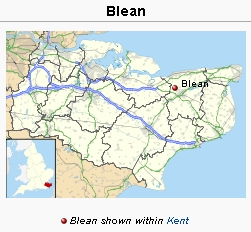 Blean
- is located in the Canterbury
district of Kent,
England. It
is the name of the civil
parish as well as the village
within it: the latter is scattered along the road between Canterbury and Whitstable,
in the middle of what was once the extensive Forest of
Blean.
Blean
- is located in the Canterbury
district of Kent,
England. It
is the name of the civil
parish as well as the village
within it: the latter is scattered along the road between Canterbury and Whitstable,
in the middle of what was once the extensive Forest of
Blean.
The village name of Blean is thought to have derived from the Old English word ‘blea’ which means rough ground.[1] The parish church is dedicated to St. Cosmus and St. Damian in the Blean: the ancient ecclesiastical parish carries the same title. It is a 13th century building, set away from the village.
[ This goes along with the other information that among Haganild's Vtlaghe
"Land"s was a forest that later became the "Royal"
hunting grounds. ]
The Blean - Canterbury's Ancient Woodland - The Blean is an area of
countryside and villages between the cathedral city of Canterbury and the towns
of Faversham, Whitstable and Herne Bay. It is a mosaic of villages, woodlands,
farms, local businesses, shops and pubs.
The Blean Woodlands are the largest in Kent and, in addition to their intrinsic interest as Ancient Woodland, they surround a number of attractive villages, where you can eat and drink, places to visit and local businesses, where you can buy a range of local products.
The Domesday Book Online - Kent A-E - Blean - Once in the royal forest of Blean; Blean Woods and Dunkirk Woods nearby (now a nature reserve) are all that remain.
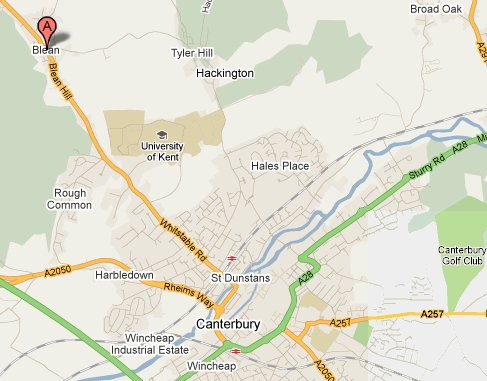 The Village of Blean
- The village is a scatter of houses on the hills north of Canterbury amid the
dwindled remains of the ancient Forest of Blean, the former domain of royal
huntsmen and later a haunt of smugglers. The forest once wooded
the whole area between the Great Stour east of Canterbury and the sea. Blean
Woods, the surviving part of the forest, is a nature reserve managed as coppice
with a wide variety of woodland plants and animals, and includes the belt of
trees south of Seasalter. The name of this strung-out village lining the road
between Canterbury and Whitstable was taken directly from the forest, which once
surrounded it. The parish is more
grandly titled St Cosmus and St Damian in the Blean
The Village of Blean
- The village is a scatter of houses on the hills north of Canterbury amid the
dwindled remains of the ancient Forest of Blean, the former domain of royal
huntsmen and later a haunt of smugglers. The forest once wooded
the whole area between the Great Stour east of Canterbury and the sea. Blean
Woods, the surviving part of the forest, is a nature reserve managed as coppice
with a wide variety of woodland plants and animals, and includes the belt of
trees south of Seasalter. The name of this strung-out village lining the road
between Canterbury and Whitstable was taken directly from the forest, which once
surrounded it. The parish is more
grandly titled St Cosmus and St Damian in the Blean
The First Church
A church was noted on the present site in 1086 (not the present building),
with a strong suggestion of an early pre-Conquest church prior to that.
There is an (unproven) folklore suggestion that the site of the present church
actually dates from 598, when the early monks accompanying Augustine from Rome
set up a shrine to the Saints Cosmus and Damian at this point on the ancient
Salt Road to the north Kent coast at Seasalter (which runs past the church).
Dedications to these two saints are very unusual in Britain (there are, in
fact, only four in the whole country), but they were at that time very well
known in Rome, where the church in their names had been opened in the Forum
as recently as 530 (the Basilica of Saints Cosmus & Damian).
Whether true or not, the whole site appears to have been fortified at some
point during the dark ages, resulting in the somewhat unusual relics of a wall
and moat around what is now our graveyard - it was most likely a fortified manor
within which a simple wooden church was included. The site became too
restricted after the Conquest, resulting in the manor itself being moved onto
what had once been the Roman villa.
These were times of great unrest, and clearly the presence of a fortified
structure belonging to Robert de Crevequer (regarded as a
"rebel" at a time of virtual civil war) at such a strategic
location proved too much for King Henry III, who in 1259 ordered that the
walls be razed to the ground and the moat filled in- in fact, only one wall
alongside the road was razed, although that was sufficient for military
purposes. To no avail, since the manor was confiscated anyway - such was
the political turbulence of the time!
Newington and Milton References:
Newington Manor, a 16th century Manor House in Newington in Kent.
Parishes - Newington British History Online
Parishes - Milton British History Online
Thirteenth-century baronies in Kent
1170 - Alan de Inglefeld to Peter son of Hagenilde and whichever of his boys he chooses for their lives, for 10s. annual rent and all services saving the King's. Witnesses: Ilger de Inglefeld, Peter the lord's uncle, Robert Puncun, Nicholas Pincerna, Robert de la More, William de Holme and Walter his brother, Walter de Molesford, and Hugh Amis. Seal missing. ½ virgate without house or 'curia' (formerly held by Roger, brother of the grantee) and 1 a. of meadow in 'Hyda Calcebuef'. Berkshire Record Office - Englefield, Berkshire - Why was Peter son of Hagenilde so important? Is there a connection to the Utlag's in Kent?
| - - - -
RBH History of
Englefield, Berkshire ... The Englefields supposedly owned the manor from the time of King Edgar the Peacemaker until it was confiscated from Sir Francis, the infamous 16th century Catholic who would not bow to the power of the English Church. He tried all sorts of ploys to stop the crown getting its hands on his lands, including settling it on his nephew. But eventually he lost out and had to flee overseas. The Englefields later bought Whiteknights Park in Earley and continued to be buried in the
Englefield Chapel in Englefield Church until 1822. Though they still have impressive monuments there, some seven fine brasses have disappeared, not least that from the elaborate 1514 tomb-chest memorial to Sir Thomas Englefield, Speaker of the House of Commons. Arches under the south wall shelter a stone knight (shield missing) and a wooden lady, probably Sir Roger Englefield (d.1317) and his wife Joan (d.1340). Nearby is a Norman pillar
piscina...
More on Chapel of Helles:
Notes on the churches in the counties of Kent, Sussex, and Surrey, mentioned ...
212. St.Margaret's, Darent.—In a document, bearing date in A.D. 1522, to the church of Darent is annexed a chapel "vulgariter nuncupata (vulgarly called) Sancte Margarette Hillis, Grensted, Southedalent, Gillis, et Hillis." (Reg. Roff.) In the description of Darent, toward the close of the last century, it was said, " There are still remaining here the flint walls of an antient building, most probably the church or chapel of South Darent, now used as a malt-house, the building of which stands due east and west." (Hasted.) Unless Thorpe (in his Gust. Roff.), (see the Note on Darent), is wrong in stating South Darent to have been joined with Horton Kirby parish, I conceive Hasted in the above passage, especially compared with the following quotation from him, can only mean St. Margaret's.—The chapel of Helles is named in a decision of Archb. John Peckhani, A.D. 1292.— St. Margaret Helles seems, from various old records, "as to its temporal jurisdiction, to have been once a parish of itself, distinct from that of Darent, having within its bounds the several hamlets of Hilles, Grensted, South Darent, and Gills. However, as to its ecclesiastical jurisdiction, it was always accounted but as a chapel to Darent, having the above hamlets within its precincts." It was united with Darent in 1557 (by Cardinal Pole, Harris), after which it was suffered to fall into ruins. Of a portion of the tower then existing it is added, "In the remains of this building there are many Roman bricks, and part of an arch is turned entirely with them." (Hasted.) He gives a small view, exhibiting a round tower-arch or doorway, and two round-headed windows, side by side, high up in the tower.
Also interesting Knights of the Shire of Kent:
Archaeologia cantiana - Kent Archaeological Society Vol 21
KNIGHTS OF THE SHIRE FOR KENT FROM A.D. 1275 TO A.D. 1831.*
BY REV. J. CAVE-BROWNE, M.A.
2 Edward III., 1328 April, Northampton.
HENRICUS DE HELLES of St. Margaret Hells near Darent, Miles, vice Stangrave.
1194-1215 - Haghenild Utlaghe - Hildith, Philip and Henry and Richard and William and Jordan, sons of Vtlag , Simon, and Adam, and Henry and Roger son of Thomas - The Outlaw's Clan in Kent
1200-1212 - De Helia Vtlagh - The rents which is due to the court of St. Augustine about the Mildelton - (Milton Kent) - Darenth - St. Margaret's of Helles - The register of St. Augustine's abbey, Canterbury, commonly called the Black book Part I
Helia ( Elijah ) Utlage or (Vtlagh from Elim - Elham) - Haghenild Utlaghe (mother) - Hildith Utlaghe (daughter) ( Very Germanic/Saxon or ?Danish/Swedish/Geatish no ? )
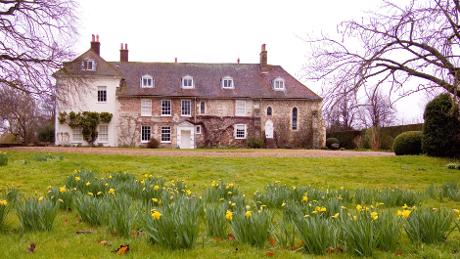
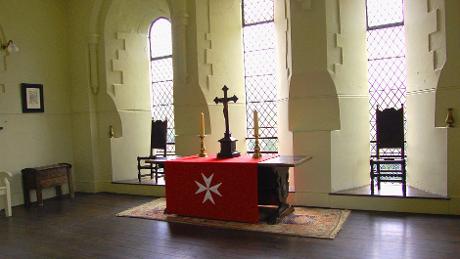
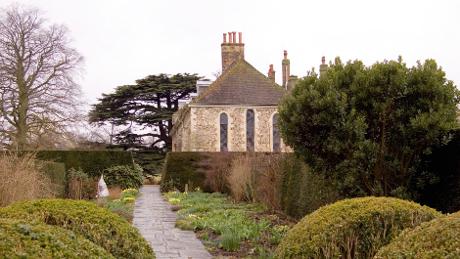
Set in the Darenth Valley, the rare surviving chapel is the only remaining structure of the Preceptory of the Knights Hospitallers of the Order of St John of Jerusalem formed in 1113.
The chapel is adjacent to a now privately occupied and much altered house, dating from the 16th century. The preceptory is thought to have gone out of use by 1338, after which time it was used as a residence.
Among its later occupants were Abraham Hill, a founder of the Royal Society, and the historian Edward Hasted. The chapel and tranquil gardens are surrounded by a moat, one arm of which is the River Darenth.
| - - -
Sutton-at-Hone - is a village 2 miles (3 km) south of Dartford in Kent, England. It is part of the Dartford local government district and the civil parish of Sutton-at-Hone and Hawley.
Sutton-at-Hone has a long history. A Commandery of the Knights Hospitaller of the Order of Saint John of Jerusalem was established in Sutton-at-Hone in 1199, and is now the National Trust property St. John's Jerusalem. The part of the St. John Jerusalem property open to the public (on Wednesday afternoons, April - October) includes the 13th century chapel of the Knights Hospitaller and a garden moated by the River Darent.
The church of St. John the Baptist was in existence by 1077. It was rebuilt in the fourteenth century, and that church had to have substantial re-building work following a fire in 1615, reputedly caused by a person firing a gun at a bird that was in the church
Sutton at Hone, in Kent is interesting since it is very close to Darenth St. Margaret Helles
Gravesend
, Kent - Darenth - The antiquity of the place is all but swamped
now but the village was once given by King Athelstan (AD 925-940) to Duke
Eadulf and later passed into the possession of Christ Church at
Canterbury, to become one of the manors of the Archbishop of Canterbury.
Archbishop Hubert Walter exchanged the church and manor of Darenth for the
manor of Lambeth in 1195.
Two of the smaller Darenth
manors, St Margaret Helle (or Helles) and Clequdon have since become lost.
The chapel of St Margaret Helle was mentioned in the Textus Roffenses,
where it was assessed at sixpence a year payable to Rochester Cathedral. In 1522
Archbishop Warham ruled that although it could baptise and bury local people,
marriages could only be solemnised at the parish church, which was some distance
away.
Nothing of the chapel remains today but the parish church continues to
be dedicated to St Margaret, also. It dates from the l0th century and its
fabric contains remnants of a nearby Roman villa on the banks of the River
Darent which was excavated in 1894/95. One of the features of the church is the
great sculpted Romanesque font which dates from about 1140. The church, which
stands on Darenth Hill, is said to be the third oldest in Kent, having been
built in about AD 940 although, of course, added to after that. It was
largely destroyed by fire in 1710 and restored.
So the bit that goes "De
Helia ": Refers
to "the Darenth manor, St Margaret Helle (or Helles)"
De Helia Vtlagh' xvd. ob.
Darenth kent england [ Notice that "forest" BEAN and Sutton-At-Hone are very close to SOUTHG Darenth (St. Margaret Helles) along with Gravesend]